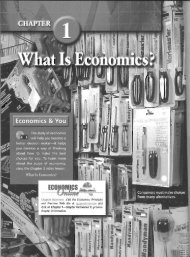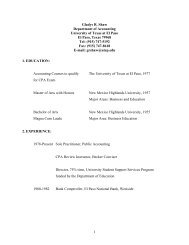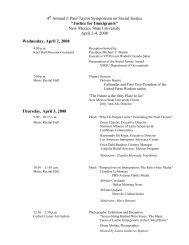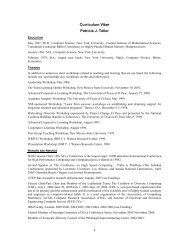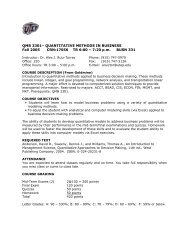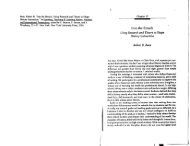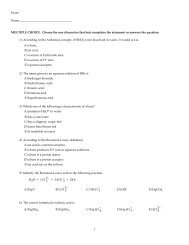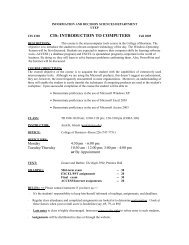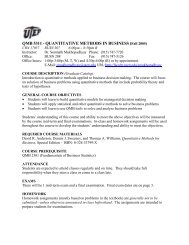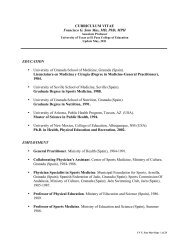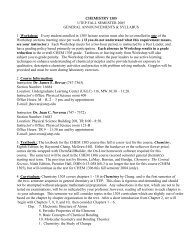Stanford-Binet Intelligence Scales, Fifth Edition ... - Faculty.utep.edu
Stanford-Binet Intelligence Scales, Fifth Edition ... - Faculty.utep.edu
Stanford-Binet Intelligence Scales, Fifth Edition ... - Faculty.utep.edu
You also want an ePaper? Increase the reach of your titles
YUMPU automatically turns print PDFs into web optimized ePapers that Google loves.
<strong>Stanford</strong>-<strong>Binet</strong> <strong>Intelligence</strong> <strong>Scales</strong>, <strong>Fifth</strong> <strong>Edition</strong> [ 233 Jmance on the:cted to beginuque way ofanding tradi:1the activitiescific level are)tests includelI'dities [Lev-Levels 2-3]);:Levels 2-6];(Form Board:"evels 3-6]);I(Block Spane [Level 1]),luid Reason- ~'erbal Absurf!s [Levels 5- '- I:Levels 2-6]; i)osition and,al Workingrels 2-3] and Iltests yield a Ith a standardAbbreviated .~lting subtests,er battery ofi'lhen a brief! SB5 varieswruch scalese not timede. The estilis45 to 75eryIQtakes:nt. Further,ter only thesubtests) or: NonverbalI minutes to!s the Nonthosewithlication disrounds,andted. This isstrument.:B5 is orga::m an easel. directions.easily viewXanu.ner toJeasily record and score responses behind the easel.The first item book includes the two routing subtests,whereas the second item book contains Levels 1-6 ofthe Nonverbal subtests. The thlrd Item book containsLevels 2-6 of the Verbal subtests.A variety of scores are derived from the rawtest data. In addition to standard scores for eachcomposite score, subtest scaled scores, percentileranks, confidence intervals, age equivalents, andChange-Sensitive Scores may be computed.Change-Sensitive Scores (CSS), based on itemresponse theory, provide a means to identify aclient's change in scores over a period of time. TheSB5 may be hand scored, but scoring can be madeeasier by using the SB5 Scoring Pro. The SB5Scoring Pro is a Windows-based program thatallows the examiner to enter background information,age, and raw scores. The resulting reportincludes an extended score report and a brief,narrative summary report that, if desired, can beexported to a word processing file for editing.DEVELOPMENT. Several significantchanges were made from the SB4 to the SB5.Frrst, the SB5 was renormed on a large, representativesample that ranged from preschool age tomature adults. The SB5 made a significant changeto the structure of the test by adding anotherfactor, Working Memory. Working Memory.vasadded because it has been shown to be related toboth reading and math achievement, and, in fact,is a deficient area in many of those children andadults with learning problems. It is also a novelarea that is not covered on many traditional testsofintelligence. Another important change includedenhanced coverage of nonverbal intelligence. TheNonverbal 10.. unlike other cognitive measures, iscomposed of nonverbal items that cover the fivefactors ofFluid Reasoning, Knowledge, Q,tantitativeReasoning, Visual-Spatial Processing, andWorking Memory. Because the U.S. population isbecoming more and more diverse, increasing thenonverbal coverage (where items require no or aminimal verbal response) was an important change.Other changes in the new edition have includ<strong>edu</strong>pdated items that extend the scales upwardand downward as well as allowing assessmentofindividuals who display very high or verylow levels offunctioning. Materials have also been"revamped" to be more appealing to both examineesand examiners. The SB5 includes "childfriendly" toys and manipulatives that are appealingto younger clients. Examiners will also welcomethe easel-style item books and computerized scoringprogram; which can make the assessmentprocess more user friendly. Further, the examinerfriendlyrecord form includes directional arrows whensums are to be transferred to another area on therecord form, bold print to identify correct answers forthe examiner, as well as lightly printed areas, whichshow the total points possible on a specific subtest., The SB5 includes comprehensive technical(Roid, 2003c) and exanu.ner's manuals. The technicalmanual guides the examiner through the testdevelopment process, which is consistent with theStandardsfor Educational and Psychological Testing(American Educational Research Association,American Psychological Association, &- NationalCouncil on Measurement in Education, 1999). Inaddition, the technical manual highlights the historyof the measure, theoretical foundations, evidenceof reliability and validity, and provides detaileddescriptions of professional and ethical useof the SB5. Furtht;:r, the examiner's manual succeedsin familiarizing the examiner with test userqualifications, assessment of special populationswith the SB5, as well as key administration, scoring,and interpretive guidelines. A more detailedSB5 interpretive manual is available, but it isdisappointing that it must be purchased separately.[Editor's Note: The publisher advises thatbeginning in 2006 the manual may be purchasedas part of the kit.]TECHNICAL. The SB5 is based on the... CatleU-Born-CarrQU(GIIG) theory of cognitivefunctioning that has been investigated empiricallyover several decades (D'Amato, Fletcher-Janzen,&- Reynolds, in press). Several other recent intelligencetests have also been based on elements ofCHC theory, and studies on earlier versions ofthe<strong>Binet</strong> scales revealed distinguishable CHC factors.The SB5 is composed of ~.factors (out of 10) oftheCHC model including (CHC factors in parentheses):Fluid Reasoning (Fluid <strong>Intelligence</strong> orGf), Knowledge (Crystallized Knowledge or Gc),Q,tantitative Reasoning (Q,tantitative Knowledgeor Gq), Visual-Spatial Processing (Visual Processingor Gv), and Working Memory (Short-TermMemory or Gsm).The selection of only five of the CHC factorsfor the SB5 was based on );:.esear~h of therelations ofthe factors to ach.ieye!11.~!1t, gi.fi,".



